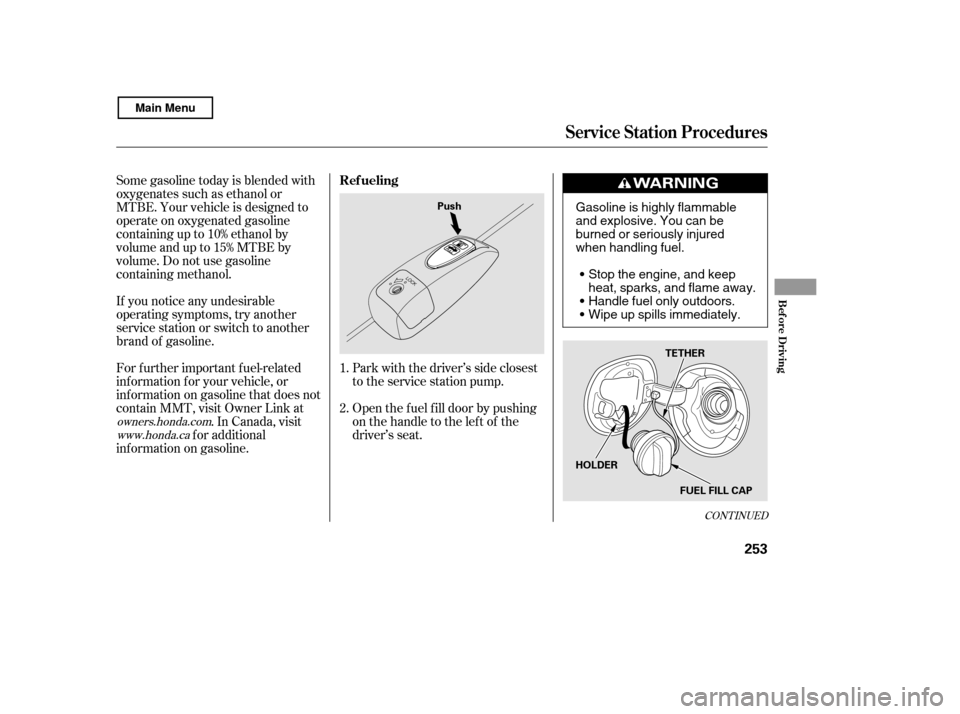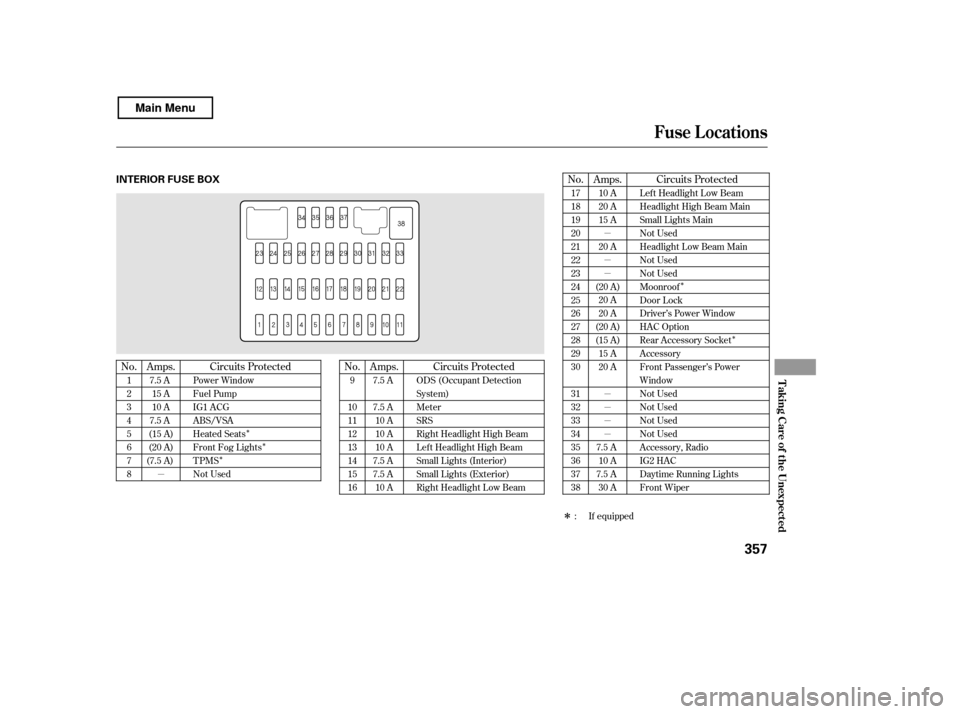Page 256 of 400

Help assure your vehicle’s f uture
reliability and perf ormance by paying
extra attention to how you drive
during the f irst 600 miles (1,000 km).
During this period:Avoid full-throttle starts and rapid
acceleration.
You should also f ollow these
recommendations with an
overhauled or exchanged engine, or
when the brakes are replaced. Avoidhardbrakingforthefirst
200 miles (300 km).
Do not change the oil until the
scheduled maintenance time. Your vehicle is designed to operate
on unleaded gasoline with a pump
octane number of 87 or higher. Use
of a lower octane gasoline can cause
a persistent, heavy, metallic rapping
noise that can lead to engine damage.
Your vehicle is designed to operate
on premium unleaded gasoline with a
pump octane number of 91 or higher.
Useof aloweroctanegasolinecan
cause occasional metallic knocking
noises in the engine and will result in
decreased engine perf ormance. Use
of a gasoline with a pump octane
number less than 87 can lead to
engine damage.
Use of gasoline with these additives
may adversely af f ect perf ormance,
and cause the malfunction indicator
lamp on your instrument panel to
come on. If this happens, contact
your authorized dealer f or service.
In addition, in order to maintain good
perf ormance, f uel economy, and
emissions control, we strongly
recommend, in areas where it is
available, the use of gasoline that
does NOT contain manganese-based
f uel additives such as MMT.
We recommend using quality
gasolines containing detergent
additives that help prevent fuel
system and engine deposits.
You may hear a knocking noise from
the engine if you drive the vehicle at
low engine speed (below about 1,000
rpm) in a higher gear. To stop this,
raise the engine speed by shif ting to
a lower gear.
Break-in Period Fuel Recommendation
Break-in Period, Fuel Recommendation
A ll models except Si
Si model only
252
Main Menu
Page 257 of 400

CONT INUED
Park with the driver’s side closest
to the service station pump.
Some gasoline today is blended with
oxygenates such as ethanol or
MTBE. Your vehicle is designed to
operate on oxygenated gasoline
containing up to 10% ethanol by
volume and up to 15% MTBE by
volume. Do not use gasoline
containing methanol.
If you notice any undesirable
operating symptoms, try another
service station or switch to another
brand of gasoline.
Open the f uel f ill door by pushing
onthehandletotheleftof the
driver’s seat.
For f urther important f uel-related
inf ormation f or your vehicle, or
inf ormation on gasoline that does not
contain MMT, visit Owner Link at
. In Canada, visit
f or additional
inf ormation on gasoline. 1. 2.
owners.honda.com
www.honda.ca
Service Station Procedures
Ref ueling
Bef ore Driving
253
Push
TETHERFUEL FILL CAP
HOLDERGasoline is highly flammable
and explosive. You can be
burned or seriously injured
when handling fuel.
Stop the engine, and keep
heat, sparks, and flame away.
Handle fuel only outdoors.
Wipe up spills immediately.
Main Menu
Page 258 of 400

Park the vehicle, and set the
parking brake. Pull the hood
release handle under the lower lef t
corner of the dashboard. The
hood will pop up slightly.
Screw the f uel f ill cap back on
until it clicks at least once. If you
do not properly tighten the cap,
the malf unction indicator lamp
maycomeon(seepage ).You
will also see a ‘‘CHECK FUEL
CAP’’ message on the inf ormation
display.
Push the f uel f ill door closed until
it latches.
Remove the f uel f ill cap slowly.
You may hear a hissing sound as
pressure inside the tank equalizes.
The fuel fill cap is attached to the
f uel f iller with a tether. Place the
cap in the holder on the f uel f ill
door.
Stop f illing the tank af ter the f uel
nozzle automatically clicks of f . Do
not try to ‘‘top off’’ the tank. This
leaves some room in the f uel tank
for the fuel to expand with
temperature changes.
If thefuelnozzlekeepsclickingoff
even though the tank is not f ull,
there may be a problem with your
vehicle’s fuel vapor recovery
system. The system helps keep
f uel vapor f rom going into the
atmosphere. Try f illing at another
pump. If this does not f ix the
problem, consult your dealer.
1.
5. 6.
4.
3.
350
Service Station Procedures
Opening and Closing the Hood
254
HOOD RELEASE HANDLE
Main Menu
Page 361 of 400

�Î�Î
�Î �Î
�Î
�µ �µ �µ �µ �µ �µ�µ�µ
�Î
No.
No. Amps. Circuits ProtectedNo. Circuits Protected
Circuits Protected
Amps. Amps.
12345678
9
10111213141516 7.5 A
7.5 A
10 A
10 A
10 A
7.5 A
7.5 A 10 A ODS (Occupant Detection
System)
Meter
SRS
Right Headlight High Beam
Left Headlight High Beam
Small Lights (Interior)
Small Lights (Exterior)
Right Headlight Low Beam 1718192021222324252627282930 31 32333435363738Left Headlight Low Beam
Headlight High Beam Main
Small Lights Main
Not Used
Headlight Low Beam Main
Not Used
Not Used
Moonroof
Door Lock
Driver’s Power Window
HAC Option
Rear Accessory Socket
Accessory
Front Passenger’s Power
Window
Not Used
Not Used
Not Used
Not Used
Accessory, Radio
IG2 HAC
Daytime Running Lights
Front Wiper
Power Window
Fuel Pump
IG1 ACG
ABS/VSA
Heated Seats
Front Fog Lights
TPMS
Not Used
If equipped
7.5 A
15 A
10 A
7.5 A
(15 A)
(20 A)
(7.5 A) 10 A
20 A
15 A
20 A
(20 A) 20 A
20 A
(20 A)
(15 A) 15 A
20 A
7.5 A 10 A
7.5 A
30 A
:
Fuse Locations
T aking Care of t he Unexpect ed
357
INTERIOR FUSE BOX
Main Menu
Page 400 of 400

Service Inf ormat ion Summary
Gasoline: Automatic Transmission Fluid:
Fuel Tank Capacity:
Recommended Engine Oil:Brake Fluid:
Tire Pressure (measured cold):
Manual Transmission Fluid:
Power Steering Fluid:
Si: Si:
Si
Si:
DX, DX-G, LX, SE, EX, EX-L:
All models except Si and
Canadian DX-G (M/T):
DX, DX-G, LX, SE, EX, EX-L:
DX, DX-G, LX, SE, EX, EX-L:
DX, DX-G
LX, SE, EX, EX-L
Unleaded gasoline, pump octane
number of 87 or higher.
13.2 US gal (50
)
API Premium grade 5W-20
detergent oil (see page ).
Oil change capacity (including
filter):
Oil change capacity (including
filter):
API Premium grade 5W-30
detergent oil (see page ). Honda Heavy Duty Brake Fluid
DOT 3 preferred, or a DOT 3 or
DOT 4 brake fluid as a temporary
replacement (see page ).
Front/Rear:
Front/Rear:
Front/Rear:
Spare Tire:
Premium unleaded gasoline,
pump octane number of 91 or
higher recommended (see ‘‘Fuel
Recommendations’’ on page ).
3.9 US qt (3.7
)
4.6 US qt (4.4
) 32 psi (220 kPa , 2.2 kgf/cm
)
32 psi (220 kPa , 2.2 kgf/cm
)
32 psi (220 kPa , 2.2 kgf/cm
)
60 psi (420 kPa , 4.2 kgf/cm
)
Honda ATF DW-1 (automatic
transmission fluid) (see page ).
Honda Manual Transmission
Fluid preferred, or an SAE 10W-30
or 10W-40 motor oil as a
temporary replacement (see page
).
Capacity (including differential):
1.5 US qt (1.4
)
1.6 US qt (1.5
)
Honda Power Steering Fluid
preferred, or another brand of
power steering fluid as a
temporary replacement. Do not
use ATF (see page ).
252
301
301 310
311
309
308
Main Menu